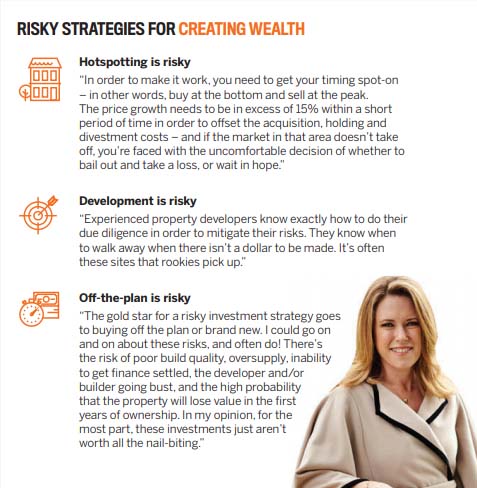06/12/2018

Now that the effects of the Australian Prudential Regulation Authority and the royal commission into banking are being felt far and wide, would-be property investors are finding it increasingly difficult – and often impossible – to obtain finance.
Since funding is becoming a scarce resource, borrowers need to be much more strategic about their investing decisions.
When pulling together your strategy and deciding what type of property to buy next, many investors will ask themselves whether they should be buying a cash flow property or a capital growth asset – but it’s the wrong question to ask, says Philippe Brach from Multifocus Property and Finance.
“When people talk about capital growth versus cash flow properties, it’s the wrong debate to have,” he says.
“When you’re going for cash flow properties, they’re usually in a regional area where you’re not going to get a lot of capital growth, but you get a better rent to compensate for that. An example of this would be Mt Isa – the returns are very high there, but it is a town that relies on one mine, and when that mine closes what is the economy of the whole area going to do? If it collapses, then so does the value of your asset.”
Brach, who is the author of Creating Property Wealth in Any Market, says he doesn’t generally believe in investing solely for a positive monthly return, though he does acknowledge the role that cash flow plays.
“Capital growth is the name of the game, but cash flow is important. You don’t want to get into a situation where interest rates increase and you’re under severe financial pressure because you can’t afford your repayments,” he says.
In that case, how do you strike the perfect balance and build a property that moves your wealth forward without costing you a fortune month to month?
 Differing performances
Differing performances
It’s a common misconception that all property goes up in value, but according to Veronica Morgan, principal at Good Deeds Property Buyers, this is simply not the case.
“Some properties lose money, some make modest gains, and some are excellent investments. Performance varies dramatically between locations, and even within an individual suburb there can be great disparity,” she says.
“But what clouds the issue even further is the fact that there is no universally accepted framework for measuring performance.”
Most people decide to invest in property because they want to accumulate wealth, Morgan explains, so they can ultimately experience financial freedom. However, the co-host of Location, Location, Location Australia on Foxtel and The Elephant in the Room property podcast, says “this dream won’t eventuate if they hold a property that doesn’t perform”.
The consequences of a poor performer could include limited ability to buy or upgrade your family home. Furthermore, the opportunity cost of “having your money tied up in a property that is not growing in value cannot be underestimated”, she adds.
“I’ve always believed that property investors should focus on capital growth rather than yield, because if you simply want to derive an income, there are other less risky and more liquid investment vehicles,” Morgan says.
“If you want positive cash flow because you can’t afford to buy in a good growth area or you want to quickly build a portfolio, then I suggest you look carefully at the risk you’re taking on.”
Choosing your property wisely
It’s commonly accepted that when you buy for yield you are typically sacrificing capital growth.
“It’s a well-accepted principle that you can’t have both at once. More than that, the areas with the greatest yields are often the lower socio-economic areas where locals don’t buy the majority of property – investors do,” Morgan says.
“However, if there is no local demand for property, when the investors pull out their money there’s only one way for prices to go, and it could be years – sometimes even decades – before you see any sign of a recovery. In order to offset the loss of capital you’ll need to get awfully high rent, and even a yield as high as 8% simply won’t cut it.”
“There is a way to magnify your returns in an A-grade location, and it requires you to fine-tune your property selection”
 That said, it’s essential that investors understand that not all property performs at the same rate in these areas, Morgan adds.
That said, it’s essential that investors understand that not all property performs at the same rate in these areas, Morgan adds.
“It’s possible to have a lemon in blue-chip suburbs, and even a B-grade property can create opportunity loss.
“For example, one property I know of – a small terrace in Sydney’s upper-crust in-demand Balmain – has actually lost traction against the rest of the market to the tune of $180,000 over 12 years. The longer the owners hold it, the further away from the rest of the market it will fall.”
While Morgan is not an advocate for cash flow performers, she stresses that cash flow must be considered – there’s no point in overcommitting to a property for long-term wealth creation if you’re going to struggle to keep up with it financially along the way.
“Investing in low-risk property will require cash input for some years, so you’ll need a good income not only to get the loan approved but also in order to maintain the investment,” she says.
For investors who are keen to find one of these ideally balanced properties, which will deliver long-term capital growth without the investor having to pitch in thousands of dollars per year to hold the asset, Morgan says the secret is simple: it all comes down to expert property selection.
“Property is a long game, and I favour blue-chip suburbs, because over time these locations have the foundations to deliver sustainable capital growth. However, there is a way to magnify your returns in an A-grade location, and it requires you to fine-tune your property selection,” she says.
“You can achieve this by understanding the characteristics that appeal to the largest proportion of buyers in any given suburb, and making sure your property is well maintained.”
WANT MORE NEWS AND FEATURES?
Visit Your Investment Property’s website
at www.yipmag.com.au